Extracts from ‘No Day Too
Long’, G S Ritchie
With additional extracts THE WAR
OF THE HALCYONS 1939‑1945 R A Ruegg World Ship Society
On the
outbreak of war, two of the four Halcyon class minesweepers which
had been completed as survey ships, JASON and GLEANER, were taken
over by the general service. The latter, in command of a surveyor,
Lieutenant Commander Price, soon distinguished herself by sinking a
U‑boat in the approaches to the Clyde.
In early 1946
these two vessels were replaced by a single Halcyon class
minesweeper which had survived the War, SHARPSHOOTER. To this ship I
was appointed as first lieutenant to oversee her conversion to a
surveying ship, at Green and Silley Weir of London, and by mid‑1946
we were on our way to the Far East under the command of Commander
Henry Menzies, a gaunt figure with a zest for life and an insatiable
enthusiasm for new hobbies. He was a competent surveyor from whom I
learnt much during the next four years.

HMS Sharpshooter in Malta en
route to Far East
(Source: Steve Prigmore)
As she sailed east she performed a
small survey in the Aden area and continued on to Trincomalee via
Bombay. On 10 July she departed Trincomalee and carried out a short
survey in the Mergui Archipelago (S. Burma coast). (Ruegg)
On our way to
Singapore we were diverted to Mergui in southern Burma to survey the
shallow approaches so that supplies of rice could be brought in to
alleviate the hardship currently endured by the people of the
Tenasserim coast. Our main tasks, however, were based on Singapore
from where we were to conduct surveys on the East Coast of Malaya
and in Sarawak.
On 25 July 1946 she sailed for Penang to locate wrecks in
the southern approaches to the port. By 3 August she was at
Singapore from whence she departed on the 24th for a month's survey
on the Malayan east coast. She then had a short stay at Singapore
before sailing for a variety of survey duties to occupy her
commission. As these duties are outside the scope of the available
war records only a
brief resume will follow to cover her later years. (Ruegg)
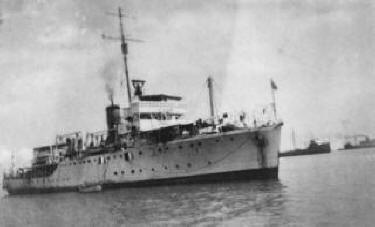

HMS Sharpshooter in
Singapore, view of Chartroom (bottom right)
(Source: Steve Prigmore)

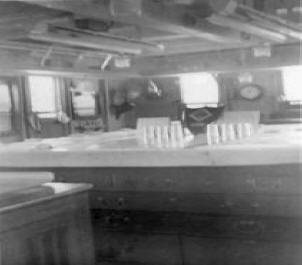
On arrival in
the Naval Base at Singapore the Flag Officer, Malayan Area,
requested that surveys of the small East Coast riverine parts of
Kuantun and Rompin be given priority so that much needed rice could
be shipped in for the natives of a remote area with few roads. It
was necessary to complete this work before the onset of the
north‑east monsoon, so while the ship underwent some minor repairs
advance parties were sent north by jeep. In previous years there was
no East Coast road, but the Japanese had constructed one. It was
little more than a track, whilst the rotting timbers of the many
bridges over the sungeis made jeep travel both laborious and at
times exciting. Unarmed, we slept happily in our camp beds in a
barnlike structure in the village of Rompin, heedless of the posters
adorning the walls denoting earlier Communist occupation. Within a
few months this was to become a no‑go area for Europeans.
Ten years
after surveying at Kermaman I was back at the site of our old
tidepole in the river. I located with ease our benchmark, which I
had cut in a massive boulder, and to which I levelled a newly
established tidepole to be read by a couple of tidewatchers
concurrently with the reading of a tidepole at Kuantun in order to
transfer our previously established datum from Kemaman. Some of the
villagers remembered our camp party; they had suffered much since
then during the Japanese occupation, and they told me that the
District Officer who had organised the building of our atap house in
1936 had been killed by the Japanese as they stormed southwards
towards Singapore.
Henry Menzies
always believed in testing his surveys with the ship, so we had a
thrilling passage in SHARPSHOOTER across the shallow Kuantan bar
over which the sea was breaking, followed by a 90°turn to starboard
into the river. We anchored off the small town of Kuantun dressed
overall for the King's Birthday and received onboard His Highness
the Sultan of Pahang a fitting end to our East Coast surveys.
The small
State of Brunei in North Borneo comprises land on either side of the
Sungei Brunei, the famed stilted village in the river, the town of
Brunei and the Sultan's Palace. The river is entered across an
extensive bar, the depths over which had not been checked since
prewar. This was SHARPSHOOTER's next task, during which a grounding
of the vessel on a sandy seabed was soon resolved by the use of
kedge anchors, the laying out of which I had already experienced in
both Herald and Endeavour.
Muara Island,
on the starboard hand as one enters the river is today, I
understand, the centre of a thriving oil industry and it is
difficult to believe that a rather stupid surveying recorder whom we
sent ashore to erect a mark on the island was lost for twenty‑four
hours in thick jungle.
Before
sailing for Brunei our medical officer was relieved by a stocky
young extrovert who came from Combined Operations together with a
motorised canoe he had 'liberated' and a number of other diverse
items. After a few days at sea the leading stoker in charge of the
mess, which was located in close proximity to the Sick Bay, asked me
if I could do something about a heavy sack which the doctor had
stowed beneath their mess table and required moving every time the
mess was scrubbed out. I bustled down to the mess deck and on
opening the sewn up sack I was surprised to find a truncated corpse.
I confronted the doctor who said that he had bought it from a
Chinaman in Singapore, it was heavily injected for preservation,
there was no room for it in the Sick Bay and he would be using it
for training his junior assistant. He did not take kindly to my
order to dispose of his precious body overboard, whilst the stokers
expressed some concern that the corpse of a Chinaman had been at
their feet as they took their daily meals.
In April 1947 we
sailed for Sarawak. Much had changed in this beautiful country since
the pre war Herald days of which I had so many happy memories……. When
we arrived in SHARPSHOOTER six months after the birth of the new
colony we found the people confused and divided, yet they clearly
retained much of the friendliness and charm I so vividly remembered
from the old days.
The British
Government's desire now was to open up their new colony and
stimulate trade, so in a country of very few roads our attention was
directed towards the improvement of commercial navigation along the
rivers. Herald, in pre war days, had surveyed the Rajang, Sarawak's
greatest river, as far as Sarekei, a small township thirty‑five
miles from the sea. SHARPSHOOTER's task was now to survey the river
for a further thirty‑five miles upstream to Sibu, the second largest
town in the country and headquarters of the Third Division. There
were a great many potential exports from Sibu including rubber,
pepper, chillies, timber, charcoal, palm oil, copra, jelutong (the
basis of chewing gum), rice and kutch (from mangrove bark, used in
tanning).
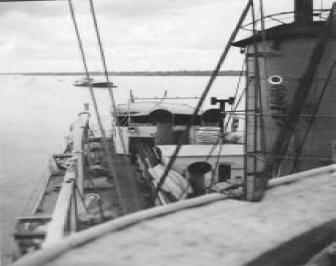
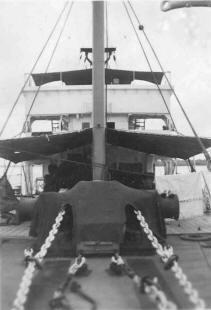
HMS Sharpshooter: boat deck
taken from bridge; forecastle and bridge.
(Source: Steve Prigmore)
The river,
which was ever busy with prahus coming and going, varies in width
from about 200 yards to a mile; for the first half of the passage to
Sibu the banks were fringed with a wide band of mangroves and nipah
palms, the leaves of the latter being used to thatch the Than (Sea
Dyak) longhouses which, built on high stilts, were to be
found at frequent intervals on either side of the river. Later a
smaller freshwater mangrove took over and more open country provided
space for the rubber gardens of the Foochow Chinese.
Little firm
coastline was to be seen on the air photographs with which we had
been provided. This dictated that the triangulation supporting the
survey would have to be carried upriver by single triangles rather
than balanced quadrilaterals, since the labour of clearing mangrove
would be disproportionate to the results achieved, whilst there
would be a chance to tie in our triangulation to the few Sarawak
survey traverse points along the way. Metre‑square collapsible
canvas covered marks were prepared by the shipwright which could be
hung in the mangrove trees beneath which a surveyor could position
himself in a folboat to observe the angles to similar marks
comprising the triangles.
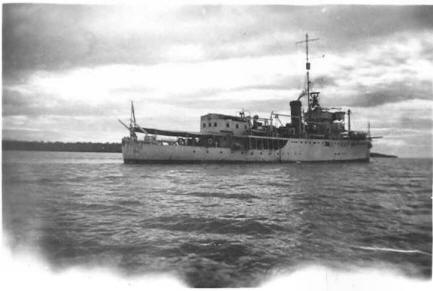
HMS Sharpshooter in Borneo
Source: Steve Prigmore
The ship
anchored off Sarikei on 19th April 1947 to recover Herald's pre-war
benchmark and to establish the first of a number of tidal observing
camps which would be required to carry the tidal datum upstream.
Here we met our first lbans wandering through the few streets buying
necessities from the Chinese stalls. The men were stocky in build,
their thick black hair cut to a fringe in front; their throats,
their arms and their thighs were tattooed with strange asymmetrical
swirling designs. They wore the briefest of loincloths with a parang
in its wooden sheath secured with a rope of coconut fibre around
their waists, or thrust into the long creel‑like baskets which they
carried on their backs. Their womenfolk, who we were to encounter
later, wore only a sarong and were of comely shape and happy
disposition.
The western
mooring dolphin off the jetty at Sarikei had been coordinated by
Herald when terminating her pre-war survey of the lower Rajang and
so, to provide a starting baseline for our own work, a boat's
taut‑wire machine, such as Berncastle and Glen had used off the
Normandy beaches, was used to measure a distance up the first reach
of the river to a terminal station established on an accessible firm
area of riverbank; the direction to the dolphin was computed from
astronomical observations made with theodolite at this terminal. The
captain's ingenuity led us to work out a system that made the best
use of all the surveying officers and recorders and our boats, even
including the doctor's motor canoe, in order to carry the survey
upstream at a rate of one to two miles a day….
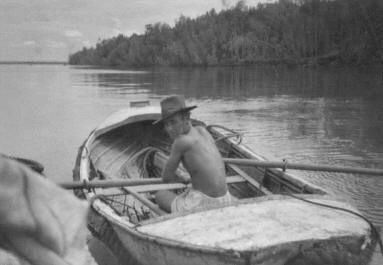
Unknown crewman, HMS
Sharpshooter
(Source: Steve Prigmore)
…Every two or
three days the ship was moved forward into the newly sounded area to
anchor nearer the scene of operations. By transferring the port
bower anchor, together with its swivel piece, to the 3˝ inch wire
towing hawser rove onto the port Oropesa winch, the ship was able to
moor head and stem in those narrower parts of the river where there
was no room to swing.
Those in the
advanced boats often spent their nights as guests in a longhouse,
thus avoiding a long upstream trip from the ship in the morning.
This was an unusual experience: throughout the night people came and
went across the creaking floors of the communal area, gangs left for
distant padi fields, groups returned from festivities in other
longhouses, unsteadily climbing the notched tree trunk, which led
from the prahu landing up to the house. Tuak, a sweet thick
alcoholic beverage distilled from rice was always in supply.
My
opportunity to spend a night in a longhouse came when Henry Menzies
moored the ship off Kampong Leman one afternoon and announced a 'hari
raya' (holiday) in honour of the King's Birthday next day. By early
evening a raft of about sixty prahus, reaching nearly to the
riverbank, was made fast to the gangway with about 300 Dyaks
squatting on the quarterdeck in readiness for the ship's film show,
in which a newsreel showing the Oxford and Cambridge boat race was
always well received with derisive shouts of 'kayu belakang'‑ or
‘paddling the wrong way round'; fortunately we also had a stock of
'Westerns' with plenty of shooting.
As night fell
a number of us, including Henry, went ashore for a party in the
nearby longhouse. Tuak was liberally served from the outset. We
admired the recently acquired stock of smoked Japanese heads hanging
from the rafters, and slowly the music began and dancing commenced.
Gongs in long wooden troughs, hollow logs and a variety of drums
were used to provide the music, whilst the dancing consisted of wild
posturings and swirlings by individuals or groups, the imitation of
which by the gangling figures of Henry and Charles Scott our senior
watchkeeper, brought shrieks of merriment from the women and
children. Time passes quickly when one is under the influence of
tuak and first light, announced by the crowing of cockerels and the
quarrelling of dogs beneath the longhouse, came all too soon. The
weary orchestra fumbled to a finish and our hosts assisted us down
the tree trunk and into the prahus for return to the ship and a
day's sleep.
Living
communally as they did, the lbans had no conception of privacy and
felt free to board the ship at any time and wander where they
pleased, a practice we did not oppose. Not one article of any
description was stolen during the five weeks it took us to reach
Sibu where SHARPSHOOTER berthed alongside on 1st July; during this
time we estimated we had played host to about 2,000 lbans….
.... For some
time it had been our captain's ambition to have a tame gibbon
onboard and this desire had been imparted to the lbans as we moved
up river. Just before we sailed from Sibu a message filtered through
that a gibbon awaited delivery in the vicinity of Binatang half way
down river to Sarikei.
I have
already mentioned Henry's love of ship handling. He had found that
in the rivers when going with the stream the ship almost steered
herself around the bends, whilst in the reverse direction canal
effect was absent, the current took the wrong bow, and it was
necessary to fight her round the bends. When the time came to sail
downriver from Sibu a great freshet was running bringing with it
huge tree trunks and great islands of vegetation. Henry was
delighted and set off downstream at a great speed, sweeping round
the bends with the minimum of help from the wheel, including the
120' turn at Leba‑an. As we approached Binatang all eyes were on the
prahus in search of the gibbon ‑ and, yes, there were four lbans
holding high a young black ape. The river here was narrow so the
decision was to anchor by the stem using the kedge anchor and lie to
the racing river waters for the transfer. I was sent to the bridge
to take charge of the ship, while Henry went to the quarterdeck to
receive the animal.
The kedge
failed to hold the ship in the strong current and we slowly dragged
downstream; only occasionally did I dare to use the engines astern
to slow our progress, fearful as I was of fouling the towing hawser.
Meanwhile the activities on the quarterdeck seemed unduly
protracted; however, at long last a smiling Henry returned to the
bridge, blood streaming from one of his fingers, but the ape ('never
call it a monkey,' said Henry) was safely belted and on its chain in
the cuddy.
Next followed
a visit to Singapore for fuel and stores before returning to
Sarawak, where a tide‑watching party was left on the small
uninhabited island of Pulo Lakei near the entrance to the Ktiching
River in order to transfer a tidal datum established there by Herald
to the Batang Lupar in the Second Division which was the next river
to be surveyed. On arrival next day in the Batang Lupar a
tide‑watching camp was established on the right bank about a quarter
of a mile from a Malay kampong near the entrance to the river.
Meanwhile a signal was received from the leading seaman in charge at
Pulo Lakei ‘Island swarming at night with giant iguanas stop Request
instructions' ‑ 'Carry a torch' was Henry's laconic reply.
The Batang
Lupar posed new problems. It was about two miles wide at its mouth
and the streams, apart from brief slack water periods, ran at
strengths between two and three and a half knots, making it
impossible to use any but the two sounding boats.


(Source: Steve Prigmore)
Henry had
wasted no time during the passage to and from Singapore in training
his gibbon and it was already extremely biddable and friendly. It
learnt to use the W.C., for peeing at least, whilst hanging by its
long arms from the deckhead, although it had not yet learnt to push
the flush!
It was
arranged that the Governor of the new colony, Sir Charles
Arden-Clark, whilst on a tour of the Second Division in his launch,
should visit SHARPSHOOTER in the Batang Lupar and take luncheon with
the captain whilst I joined the A.D.C. to make a foursome. Henry was
delighted at the opportunity to show off the gibbon, which was
restricted to the starboard side of the cuddy by its belt and chain.
After lunch, when seated in armchairs to take coffee, I noticed that
the gibbon, hanging by its arms from the deckhead, was fascinated by
the plume of feathers on the Governor's hat, on the table beside
him, which was being gently agitated by an overhead fan. Suddenly,
at the end of its tether, the gibbon aimed a copious jet towards the
ornate head gear. The effort fell slightly short of target but never
have I seen a vice‑regal visit so abruptly concluded as the coxswain
and quartermaster were rapidly assembled to pipe the 'Still' for the
Governor's departure.
On return
from a brief visit by the ship to Kuching I was despatched with
Petty Officer Slater, the coxswain, in a surveying motorboat to see
how the tide‑watchers were faring. At the tidepole among the
mangroves we found a crude notice affixed to a tree ‑ 'Gon Kampong
back soon, Abang.' Within five minutes, on nearing the hour, a young
Malay carrying the 'Record of Tide Readings' book emerged from the
soggy pathway. He was taken aback when he saw us but nevertheless
composed himself sufficiently to record the hourly tidepole reading
before we started to question him as to the whereabouts of the
leading seaman and his two fellow tide‑watchers. He indicated
haltingly that as 'Charlie' was getting married to an upriver Dyak
woman the whole party had gone for the celebrations, leaving him in
charge of the tidepole. Informing the ship by radio of these
surprising developments we set out upriver against a strong ebbing
current. In time the first longhouses appeared, deserted except for
a few old men and women who waved onwards whither the young people
had gone to celebrate. After three or four hours of travelling we
heard a distant cacophony of gongs, drums and the human voice which
led us eventually into a backwater and to a longhouse alive with
activity and merriment. Seldom have two uninvited guests been so
unwelcome at a wedding party. Refusing offers of roast pig and
foaming tuak we arrested the three absentee tide‑watchers, dressed
in sarongs, their heads bedecked with flowers, whilst the young
bride clung to Stoker Charlie Ledger weeping copiously. It was dark
long before we reached the ship with our deflated captives who were
charged on arrival with being absent from their place of duty,
perhaps a less serious crime than desertion which could equally have
met the case.
Charles
Ledger, a 'hostilities only' rating, had, like a number of others
onboard been keenly awaiting news of his discharge. As a former
Yorkshire miner he had received priority, and orders to arrange an
immediate passage for him to U.K. had been received onboard during
the recent visit to Kuching. There were some sad days in the river
when daily the young bride and her mother arrived alongside byprahu
and were allowed to converse with Charles, who was confined to the
ship, from the quarterdeck. Meanwhile messages between the ship and
the authorities in Kuching elicited the fact that a marriage of this
nature was not recognisable in law, and the hope must be that,
as Ledger returned to the coalface, his Dyak bride found a more
suitable husband to provide for her in the jungles of Sarawak.
There was no
particular task for the doctor in the survey of the Batang Lupar so
he spent most of his days lying on the bridge chart table enduring
the daily increasing pain as a Dyak tattooist tap‑tapped with a
hand‑held needle to impose a native tattoo on his shoulder. Only
tots of brandy brought to him by his fellow Idlers enabled him to
see the work completed……
…..When
SHARPSHOOTER had sailed from England in May 1946 we were told that
we should be away for a limited period until we were relieved by
Dampier, the first of four Bay Class frigates which, with war ended,
were being completed as survey ships. At long last news of Dampier's
completion was received and we realised that with luck we should be
home a few days before Christmas after eighteen months' absence.
There was,
however, one last task to be tackled. Port Swettenharn, the port
serving the capital of Malaya, Kuala Lumpur, was now quite
inadequate for post‑war trade and plans had been drawn up for the
establishment of extensive wharves in the closely adjacent North
Klang Strait. The Strait was bordered with a wide and ancient
mangrove forest. Here the scale of the survey for the port
development was large, necessitating a second order triangulation to
be carried through the swamps where 'jet propelled clearers' were
unavailable. So we had to clear lanes ourselves up to half a mile in
length; many days were spent either up to our waists in water or
knee deep in mud as we hacked away at the iron‑hard mangrove trees
with an assortment of axes, choppers and parangs, nightly
re‑sharpened by the shipwright. Eventually the sightlines were
clear, platforms were built above the mud to facilitate theodolite
observations, the triangulation was balanced and plotted and the
work of sounding North Klang Strait completed.
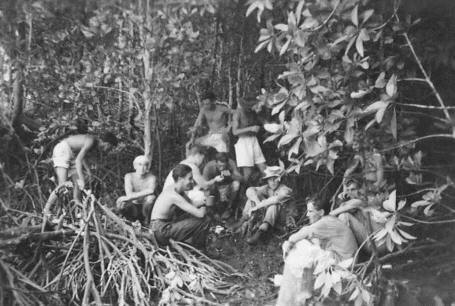
Crew of HMS Sharpshooter in the
jungle - Malaya
(Source: Steve Prigmore)
Henry had
found a good home for his gibbon with friends in Singapore, and for
the long voyage home he turned his attention to rug‑making devising
his own pattern of a bluish grey Dyak tattoo on a brown skin
background. By the time we reached Chatham a magnificent and unusual
hearth rug adorned the cuddy. In front of the bridge the ship
carried a great wooden carved and gaudily painted 'Kenyalang', the
mythical bird of good omen of the Borneo jungles, to remind us, had
that been necessary, of our life among the lbans of Sarawak.


